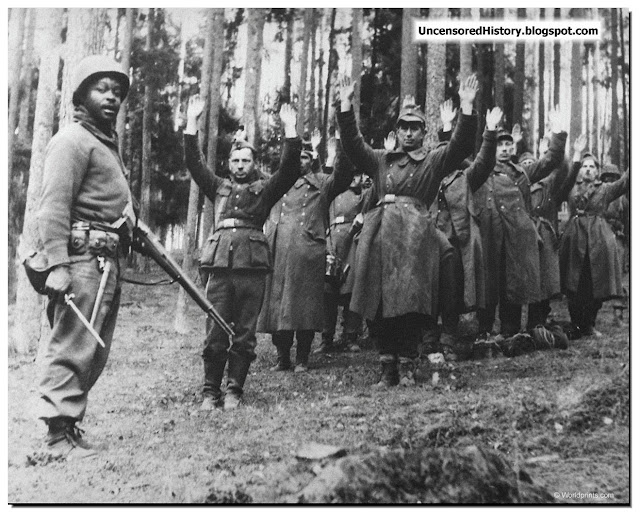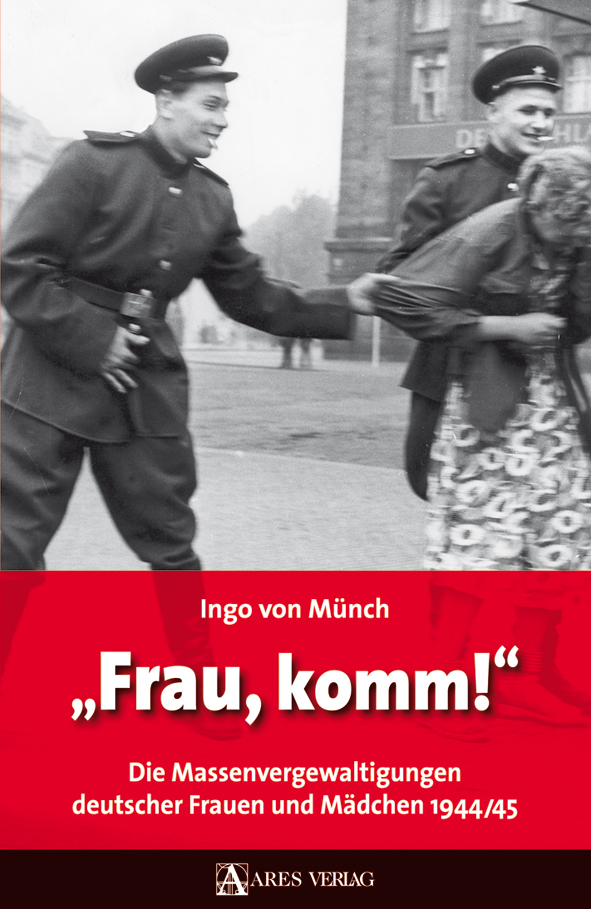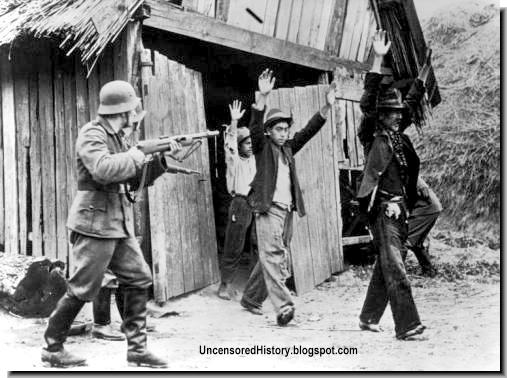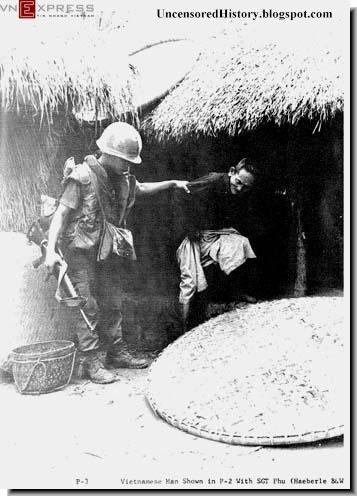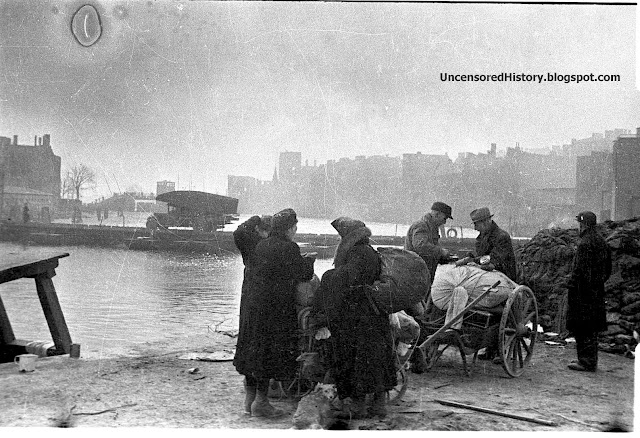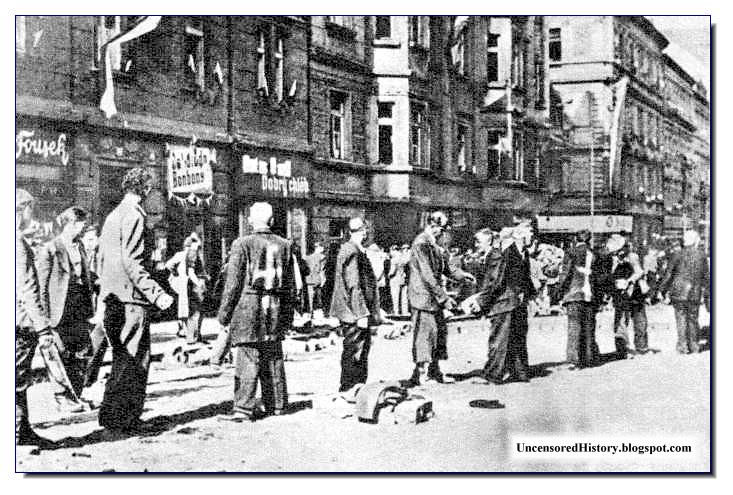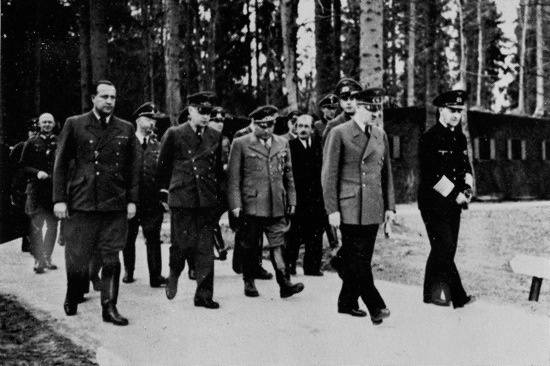 |
| The Togoshi Railway station in Tokyo. March. 1945 |
 |
| Tokyo residents who lost their homes as a result of the U.S. bombing of the city. March 10, 1945. |
 |
| A Street in Tokyo. March 10, 1945 |
"They set to work at once sowing the sky with fire. Bursts of light flashed everywhere in the darkness like Christmas trees lifting their decorations of flame high into the night, then fell back to earth in whistling bouquets of jagged flame. Barely a quarter of an hour after the raid started, the fire, whipped by the wind, began to scythe its way through the density of that wooden city.
"Around midnight, the first Superfortresses dropped hundreds of clusters of the incendiary cylinders the people called "Molotov flower baskets," marking out the target zone with four or five big fires. The planes that followed, flying lower, circled and crisscrossed the area, leaving great rings of fire behind them. Soon other waves came in to drop their incendiaries inside the "marker" circles. Hell could be no hotter. The inhabitants stayed heroically put as the bombs dropped, faithfully obeying the order that each family defend its own home. But how could they fight the fires with that wind blowing and when a single house might be hit by ten or even more of the bombs, each weighing up to 6.6 pounds, that were raining down by the thousands? As they fell, cylinders scattered a kind of flaming dew that skittered along the roofs, setting fire to everything it splashed and spreading a wash of dancing flames everywhere - the first version of napalm, of dismal fame. The meager defenses of those thousands of amateur firemen - feeble jets of hand-pumped water, wet mats and sand to be thrown on the bombs when one could get close enough to their terrible heat were completely inadequate. Roofs collapsed under the bombs' impact and within minutes the frail houses of wood and paper were aflame, lighted from the inside like paper lanterns. The hurricane-force wind puffed up great clots of flame and sent burning planks planing through the air to fell people and set fire to what they touched. Flames from a distant cluster of houses would suddenly spring up close at hand, traveling at the speed of a forest fire. Then screaming families abandoned their homes; sometimes the women had already left, carrying their babies and dragging crates or mattresses. Too late: the circle of fire had closed off their street. Sooner or later, everyone was surrounded by fire. The police were there and so were detachments of helpless firemen who for a while tried to control the fleeing crowds, channeling them toward blackened holes where earlier fires had sometimes carved a passage. In the rare places where the fire hoses worked - water was short and the pressure was low in most of the mains - firemen drenched the racing crowds so that they could get through the barriers of flame. Elsewhere, people soaked themselves in the water barrels that stood in front of each house before setting off again. A litter of obstacles blocked their way; telegraph poles and the overhead trolley wires that formed a dense net around Tokyo fell in tangles across streets. In the dense smoke, where the wind was so hot it seared the lungs, people struggled, then burst into flames where they stood. The fiery air was blown down toward the ground and it was often the refugees' feet that began burning first: the men's puttees and the women's trousers caught fire and ignited the rest of their clothing. Proper air-raid clothing as recommended by the government to the civilian population consisted of a heavily padded hood over the head and shoulders that was supposed chiefly to protect people's ears from bomb blasts-explosives, that is. But for months, Tokyo had mostly been fire-bombed. The hoods flamed under the rain of sparks; people who did not burn from the feet up burned from the head down. Mothers who carried their babies strapped to their backs, Japanese style, would discover too late that the padding that enveloped the infant had caught fire. Refugees clutching their packages crowded into the rare clear spaces - crossroads, gardens and parks - but the bundles caught fire even faster than clothing and the throng flamed from the inside. Hundreds of people gave up trying to escape and, with or without their precious bundles, crawled into the holes that served as shelters; their charred bodies were found after the raid. Whole families perished in holes they had dug under their wooden houses because shelter space was scarce in those overpopulated hives of the poor; the house would collapse and burn on top of them, braising them in their holes. Tokyo after the raid The fire front advanced so rapidly that police often did not have time to evacuate threatened blocks even if a way out were open. And the wind, carrying debris from far away, planted new sprouts of fire in unexpected places. Firemen from the other half of the city tried to move into the inferno or to contain it within its own periphery, but they could not approach it except by going around it into the wind, where their efforts were useless or where everything had already been incinerated. The same thing happened that had terrorized the city during the great fire of 1923: ...under the wind and the gigantic breath of the fire, immense, incandescent vortices rose in a number of places, swirling, flattening sucking whole blocks of houses into their maelstrom of fire. Wherever there was a canal, people hurled themselves into the water; in shallow places, people waited, half sunk in noxious muck, mouths just above the surface of the water. Hundreds of them were later found dead; not drowned, but asphyxiated by the burning air and smoke. In other places, the water got so hot that the luckless bathers were simply boiled alive. Some of the canals ran directly into the Sumida; when the tide rose, people huddled in them drowned. In Asakusa and Honjo, people crowded onto the bridges, but the spans were made of steel that gradually heated; human clusters clinging to the white-hot railings finally let go, fell into the water and were carried off on the current. Thousands jammed the parks and gardens that lined both banks of the Sumida. As panic brought ever fresh waves of people pressing into the narrow strips of land, those in front were pushed irresistibly toward the river; whole walls of screaming humanity toppled over and disappeared in the deep water. Thousands of drowned bodies were later recovered from the Sumida estuary. Sirens sounded the all-clear around 5 A.M. - those still working in the half of the city that had not been attacked; the other half burned for twelve hours more. I talked to someone who had inspected the scene an March 11. What was most awful, my witness told me, was having to get off his bicycle every couple of feet to pass over the countless bodies strewn through the streets. There was still a light wind blowing and some of the bodies, reduced to ashes, were simply scattering like sand. In many sectors, passage was blocked by whole incinerated crowds." |
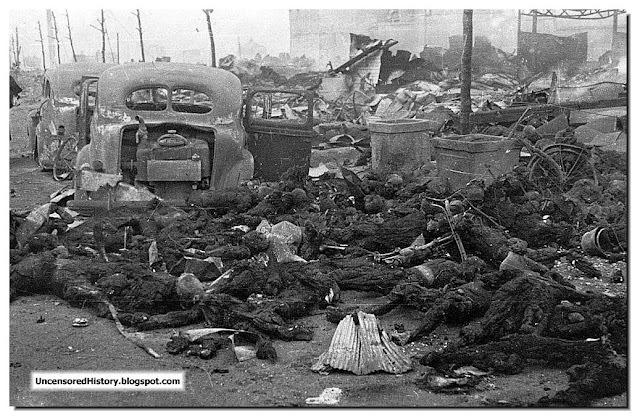 |
| The effect of the American incendiary bombing. Burnt bodies of Tokyo residents. March 1945 |
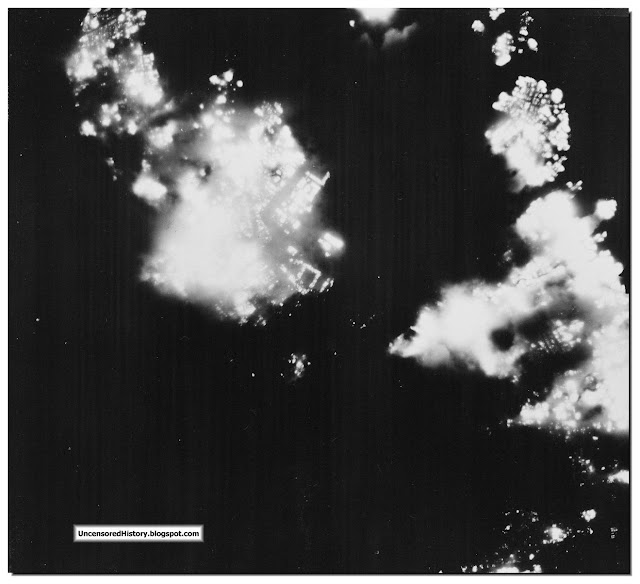 |
| Aerial view of night bombing of the Japanese city of Shizuoka. The photo shows the flash of a bomb explosion and fire caused by bombing. |
The raid also represented a tactical shift, as the Americans switched from high-altitude precision bombing to low-altitude incendiary raids. Tokyo was the first of five incendiary raids launched in quick succession against the largest Japanese cities. Nagoya, Osaka and Kobe were also targeted — with Nagoya getting hit twice within a week. By the end of the war, more than 60 Japanese cities had been laid waste by firebombing.
The Tokyo raid, codenamed Operation Meetinghouse, began an aerial onslaught so effective that the American air command concluded by July 1945 that no viable targets remained on the Japanese mainland. But if the American objective was to shorten the war by demoralizing the Japanese population and breaking its will to resist, it didn't work. What had proven true in Germany proved equally true here: Morale was shaken by bombing, but once the shock passed, the war work went on.
The Americans began looking to incendiaries as their stockpiles of those weapons increased, and because the typically cloudy weather conditions that prevailed over Japan made precision bombing difficult at best. Maj. Gen. Curtis LeMay, commander of the 21st Bomber Command, also argued that incendiary bombing would be particularly effective, because Japanese cities contained a lot of tightly packed, wooden structures that would burn easily when set alight.
He was right. The B-29 bombers for the Tokyo raid were stripped of their defensive weapons and packed with various incendiary explosives, including white phosphorus and napalm, a new gasoline-based, fuel-gel mixture developed at Harvard University. As opposed to the high-altitude precision bombing, which the Allies practiced with only mixed success over both Germany and Japan, incendiary raids were carried out at low altitudes of between 5,000 and 9,000 feet.
The attackers were helped by the fact that Japanese air defenses were almost nonexistent by that point in the war. In fact, only 14 B-29s were lost in the March 9-10 Tokyo raid. As was done in Europe, pathfinder planes flying ahead of the bombers marked the target with a flaming X, guiding the attackers in. Tokyo was hit over a three-hour period by three bomber streams that dropped roughly 2,000 tons of incendiaries near the docklands and in the industrial heart of the Japanese capital.
Tokyo immediately burst into flames. The combination of incendiaries, the way they were dropped, windy weather conditions and lack of coordinated firefighting on the ground resulted in a firestorm similar to what occurred two years previously in Hamburg, and only a month before in Dresden. Temperatures on the ground in Tokyo reached 1,800 degrees in some places.
The human carnage was appalling; bomber crews coming in near the tail end of the raid reported smelling the stench of charred human flesh as they passed over the burning capital. Sixty-three percent of Tokyo's commercial area, and 18 percent of its industry, was destroyed. An estimated 267,000 buildings burned to the ground. The firebombing campaign, coupled with the atomic bombings of Hiroshima and Nagasaki, are believed to have killed more than 1 million Japanese civilians between March and August of 1945.
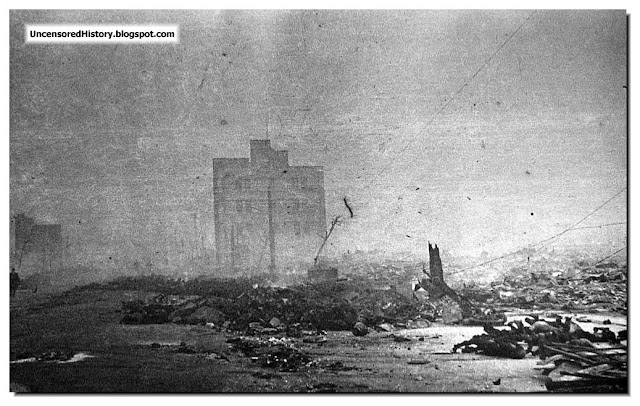 |
| Ash, debris and burned bodies in Tokyo. March 1945 |
But it was in the Pacific theatre, and specifically in Japan, that the full brunt of air power would be felt. Between 1932 and 1945, Japan had bombed Shanghai, Nanjing, Chongqing and other cities, testing chemical weapons in Ningbo and throughout Zhejiang province. In the early months of 1945, the United States shifted its attention to the Pacific as it gained the capacity to attack Japan from newly captured bases in Tinian and Guam. While the US continued to proclaim adherence to tactical bombing, tests of firebombing options against Japanese homes throughout 1943-44 demonstrated that M-69 bombs were highly effective against the densely packed wooden structures of Japanese cities. In the final six months of the war, the US threw the full weight of its air power into campaigns to burn whole Japanese cities to the ground and terrorize, incapacitate and kill their largely defenseless residents in an effort to force surrender.
As Michael Sherry and Cary Karacas have pointed out for the US and Japan respectively, prophecy preceded practice in the destruction of Japanese cities, and well before US planners undertook strategic bombing. Thus Sherry observes that “Walt Disney imagined an orgiastic destruction of Japan by air in his 1943 animated feature Victory Through Air Power (based on Alexander P. De Seversky’s 1942 book),” while Karacas notes that the best-selling Japanese writer Unna Juzo, beginning in his early 1930s “air-defense novels”, anticipated the destruction of Tokyo by bombing. Both reached mass audiences in the US and Japan, in important senses anticipating the events to follow.
LeMay was the primary architect, a strategic innovator, and most quotable spokesman for US policies of putting enemy cities, and later villages and forests, to the torch from Japan to Korea to Vietnam. In this, he was emblematic of the American way of war that emerged from World War II. Viewed from another angle, however, he was but a link in a chain of command that had begun to conduct area bombing in Europe. That chain of command extended upward through the Joint Chiefs to the president who authorized what would become the centerpiece of US warfare.
The US resumed bombing of Japan after a two-year lull following the 1942 Doolittle raids in fall 1944. The goal of the bombing assault that destroyed Japan’s major cities in the period between May and August 1945, the US Strategic Bombing Survey explained, was “either to bring overwhelming pressure on her to surrender, or to reduce her capability of resisting invasion. . . . [by destroying] the basic economic and social fabric of the country.” A proposal by the Chief of Staff of the Twentieth Air Force to target the imperial palace was rejected, but in the wake of successive failures to eliminate such key strategic targets as Japan’s Nakajima Aircraft Factory west of Tokyo, the area bombing of Japanese cities was approved.
The full fury of firebombing and napalm was unleashed on the night of March 9-10, 1945 when LeMay sent 334 B-29s low over Tokyo from the Marianas. Their mission was to reduce the city to rubble, kill its citizens, and instill terror in the survivors, with jellied gasoline and napalm that would create a sea of flames. Stripped of their guns to make more room for bombs, and flying at altitudes averaging 7,000 feet to evade detection, the bombers, which had been designed for high-altitude precision attacks, carried two kinds of incendiaries: M 47s, 100-pound oil gel bombs, 182 per aircraft, each capable of starting a major fire, followed by M 69s, 6-pound gelled-gasoline bombs, 1,520 per aircraft in addition to a few high explosives to deter firefighters. The attack on an area that the US Strategic Bombing Survey estimated to be 84.7 percent residential succeeded beyond the wildest dreams of air force planners. Whipped by fierce winds, flames detonated by the bombs leaped across a fifteen square mile area of Tokyo generating immense firestorms that engulfed and killed scores of thousands of residents.
In contrast with Vonnegut’s “wax museum” description of Dresden victims, accounts from inside the inferno that engulfed Tokyo chronicle scenes of utter carnage. We have come to measure the efficacy of bombing by throw weights and kill ratios, eliding the perspectives of their victims. But what of those who felt the wrath of the bombs?
Police cameraman Ishikawa Koyo described the streets of Tokyo as
“rivers of fire . . . flaming pieces of furniture exploding in the heat, while the people themselves blazed like ‘matchsticks’ as their wood and paper homes exploded in flames. Under the wind and the gigantic breath of the fire, immense incandescent vortices rose in a number of places, swirling, flattening, sucking whole blocks of houses into their maelstrom of fire.”
Father Flaujac, a French cleric, compared the firebombing to the Tokyo earthquake twenty-two years earlier, an event whose massive destruction, another form of prophecy, had alerted both Japanese science fiction writers and some of the original planners of the Tokyo holocaust:
In September 1923, during the great earthquake, I saw Tokyo burning for 5 days. I saw in Honjo a heap of 33,000 corpses of people who burned or suffocated at the beginning of the bombardment . . . After the first quake there were 20-odd centers of fire, enough to destroy the capital. How could the conflagration be stopped when incendiary bombs in the dozens of thousands now dropped over the four corners of the district and with Japanese houses which are only match boxes? . . . Where could one fly? The fire was everywhere.Nature reinforced man's handiwork in the form of akakaze, the red wind that swept with hurricane force across the Tokyo plain and propelled firestorms across the city with terrifying speed and intensity. The wind drove temperatures up to eighteen hundred degrees Fahrenheit, creating superheated vapors that advanced ahead of the flames, killing or incapacitating their victims. "The mechanisms of death were so multiple and simultaneous—oxygen deficiency and carbon monoxide poisoning, radiant heat and direct flames, debris and the trampling feet of stampeding crowds—that causes of death were later hard to ascertain . . .”
The Strategic Bombing Survey, whose formation a few months earlier provided an important signal of Roosevelt’s support for strategic bombing, provided a technical description of the firestorm and its effects on Tokyo:
The chief characteristic of the conflagration . . . was the presence of a fire front, an extended wall of fire moving to leeward, preceded by a mass of pre-heated, turbid, burning vapors . . . . The 28-mile-per-hour wind, measured a mile from the fire, increased to an estimated 55 miles at the perimeter, and probably more within. An extended fire swept over 15 square miles in 6 hours . . . . The area of the fire was nearly 100 percent burned; no structure or its contents escaped damage.
The survey concluded—plausibly, but only for events prior to August 6, 1945—that
“probably more persons lost their lives by fire at Tokyo in a 6-hour period than at any time in the history of man. People died from extreme heat, from oxygen deficiency, from carbon monoxide asphyxiation, from being trampled beneath the feet of stampeding crowds, and from drowning. The largest number of victims were the most vulnerable: women, children and the elderly.”
How many people died on the night of March 9-10 in what flight commander Gen. Thomas Power termed “the greatest single disaster incurred by any enemy in military history?” The Strategic Bombing Survey estimated that 87,793 people died in the raid, 40,918 were injured, and 1,008,005 people lost their homes. Robert Rhodes, estimating the dead at more than 100,000 men, women and children, suggested that probably a million more were injured and another million were left homeless. The Tokyo Fire Department estimated 97,000 killed and 125,000 wounded. The Tokyo Police offered a figure of 124,711 killed and wounded and 286,358 building and homes destroyed. The figure of roughly 100,000 deaths, provided by Japanese and American authorities, both of whom may have had reasons of their own for minimizing the death toll, seems to me arguably low in light of population density, wind conditions, and survivors’ accounts. [28] With an average of 103,000 inhabitants per square mile and peak levels as high as 135,000 per square mile, the highest density of any industrial city in the world, and with firefighting measures ludicrously inadequate to the task, 15.8 square miles of Tokyo were destroyed on a night when fierce winds whipped the flames and walls of fire blocked tens of thousands fleeing for their lives. An estimated 1.5 million people lived in the burned out areas. Given a near total inability to fight fires of the magnitude produced by the bombs, it is possible to imagine that casualties may have been several times higher than the figures presented on both sides of the conflict. The single effective Japanese government measure taken to reduce the slaughter of US bombing was the 1944 evacuation to the countryside of 400,000 children from major cities, 225, 000 of them from Tokyo.
Following the attack, LeMay, never one to mince words, said that he wanted Tokyo “burned down—wiped right off the map” to “shorten the war.” Tokyo did burn. Subsequent raids brought the devastated area of Tokyo to more than 56 square miles, provoking the flight of millions of refugees.
Source: http://www.japanfocus.org/-mark-selden/2414
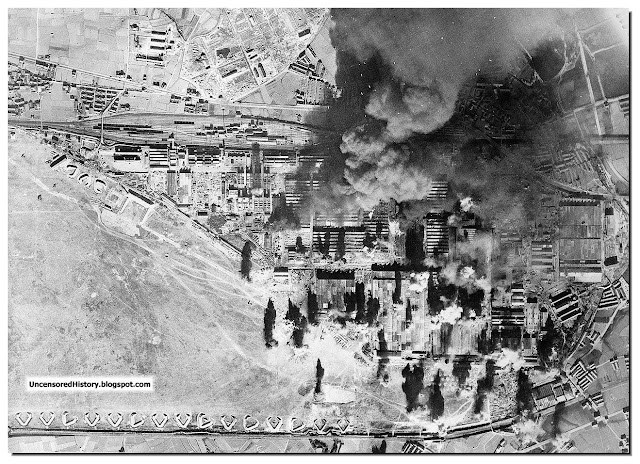 |
| Aerial view of the bombing of the factory of Kawasaki Corporation |
 |
| Aerial view of Yokohama after the bombing |
 |
| Aerial view of the effects of a night bombing of Tokyo |
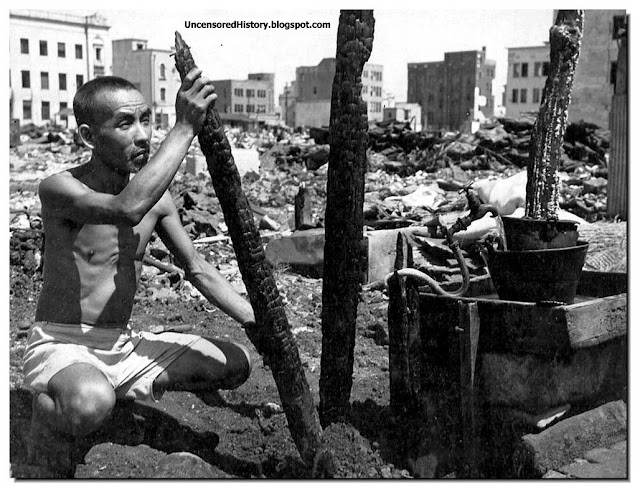 |
| Japanese at the ruins of his home in Yokohama. |
 |
| The "villain". The B 29 Superfortress American bomber |
























